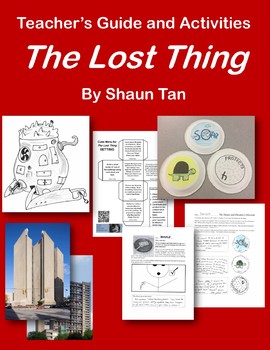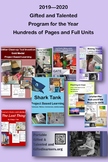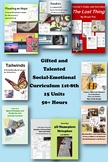The Lost Thing by Shaun Tan - Teacher's Guide and Activities GATE
Portable Gifted and Talented
3.1k Followers
Grade Levels
4th - 12th, Homeschool
Subjects
Resource Type
Standards
CCSSRL.4.1
CCSSRL.4.7
CCSSRL.5.1
CCSSRL.5.7
CCSSRL.6.1
Formats Included
- Word Document File
Pages
47 pages
Portable Gifted and Talented
3.1k Followers
Also included in
- Hours and hours and hundreds and hundreds of pages. Renew, refresh, and re-energize with engaging, challenging hands-on products!THESE PROGRAMS FOR THE YEAR ARE MY MOST POPULAR PRODUCTS.Inspire your students with FLOATING ON HOPE. Your youngest KG kids and 1st graders will love MAKING TRACKS. ThePrice $19.99Original Price $37.91Save $17.92
- This bundle is a variation on my popular social-emotional curriculum which is going live and in print in the spring of 2021.These social-emotional units span the curriculum with creative, hands-on activities . . . because we need to make excellent use of our time in gifted and talented talent poolsPrice $19.09Original Price $33.43Save $14.34
Description
The beauty in The Lost Thing is that it settles into one’s soul in a casual and poetic way. What starts as a sort of amusing but sad story finds its way deeper into your heart. You begin to wonder, to ask questions. Soon you find yourself wanting to stand up and defend all the lost things in the world—including that lost part of yourself.
Are you somehow guilty too, you wonder? Quite unexpectedly, you begin to really feel the world Shaun Tan creates. It is a wonderful experience in mindfulness and a poem in words and drawings that reaches out toward you even with its tiniest, bleak hands. You didn’t expect to be affected so deeply by a picture book, yet here you are . . . a more thoughtful, empathic, and better person for it.
We will teach reading, writing, speaking and listening, and critical thinking skills using this wondrous picture book—and these creative activities work with 4th graders and 12th graders alike!
The Lost Thing is a journey about who we are, where we are now, and the humanity we share. The Lost Thing manages to be about hope and belonging and despair and not belonging at the same time. As Shaun Tan says, “I’m not really sure if it’s a sad story or a happy one.” This book should be in every mindful classroom!
This unit contains interpretive/analytical questions and is Common Core Standards referenced. We analyze the setting with the strength of visual learning in mind, learn about Bauhaus and Brutalism in architecture, and imagine just what’s inside the Lost Thing before we create our own “Lost Thing.”
The Bottle Caps Collection Mystery and Hopes and Dreams Collection is a social-emotional lesson and public speaking opportunity. Students think about themselves and their goals and then share their ideas with others in a non-threatening public speaking opportunity using visual aids they’ve created.
Finally, we create metaphors through a hands-on graphic design activity and finish with an analysis of the academy award-winning animated short of The Lost Thing.
You’ll have everything you need right here in this download—except the book—to get started tomorrow!
Are you somehow guilty too, you wonder? Quite unexpectedly, you begin to really feel the world Shaun Tan creates. It is a wonderful experience in mindfulness and a poem in words and drawings that reaches out toward you even with its tiniest, bleak hands. You didn’t expect to be affected so deeply by a picture book, yet here you are . . . a more thoughtful, empathic, and better person for it.
We will teach reading, writing, speaking and listening, and critical thinking skills using this wondrous picture book—and these creative activities work with 4th graders and 12th graders alike!
The Lost Thing is a journey about who we are, where we are now, and the humanity we share. The Lost Thing manages to be about hope and belonging and despair and not belonging at the same time. As Shaun Tan says, “I’m not really sure if it’s a sad story or a happy one.” This book should be in every mindful classroom!
This unit contains interpretive/analytical questions and is Common Core Standards referenced. We analyze the setting with the strength of visual learning in mind, learn about Bauhaus and Brutalism in architecture, and imagine just what’s inside the Lost Thing before we create our own “Lost Thing.”
The Bottle Caps Collection Mystery and Hopes and Dreams Collection is a social-emotional lesson and public speaking opportunity. Students think about themselves and their goals and then share their ideas with others in a non-threatening public speaking opportunity using visual aids they’ve created.
Finally, we create metaphors through a hands-on graphic design activity and finish with an analysis of the academy award-winning animated short of The Lost Thing.
You’ll have everything you need right here in this download—except the book—to get started tomorrow!
Total Pages
47 pages
Answer Key
N/A
Teaching Duration
Other
Report this resource to TPT
Reported resources will be reviewed by our team. Report this resource to let us know if this resource violates TPT’s content guidelines.
Standards
to see state-specific standards (only available in the US).
CCSSRL.4.1
Refer to details and examples in a text when explaining what the text says explicitly and when drawing inferences from the text.
CCSSRL.4.7
Make connections between the text of a story or drama and a visual or oral presentation of the text, identifying where each version reflects specific descriptions and directions in the text.
CCSSRL.5.1
Quote accurately from a text when explaining what the text says explicitly and when drawing inferences from the text.
CCSSRL.5.7
Analyze how visual and multimedia elements contribute to the meaning, tone, or beauty of a text (e.g., graphic novel, multimedia presentation of fiction, folktale, myth, poem).
CCSSRL.6.1
Cite textual evidence to support analysis of what the text says explicitly as well as inferences drawn from the text.







